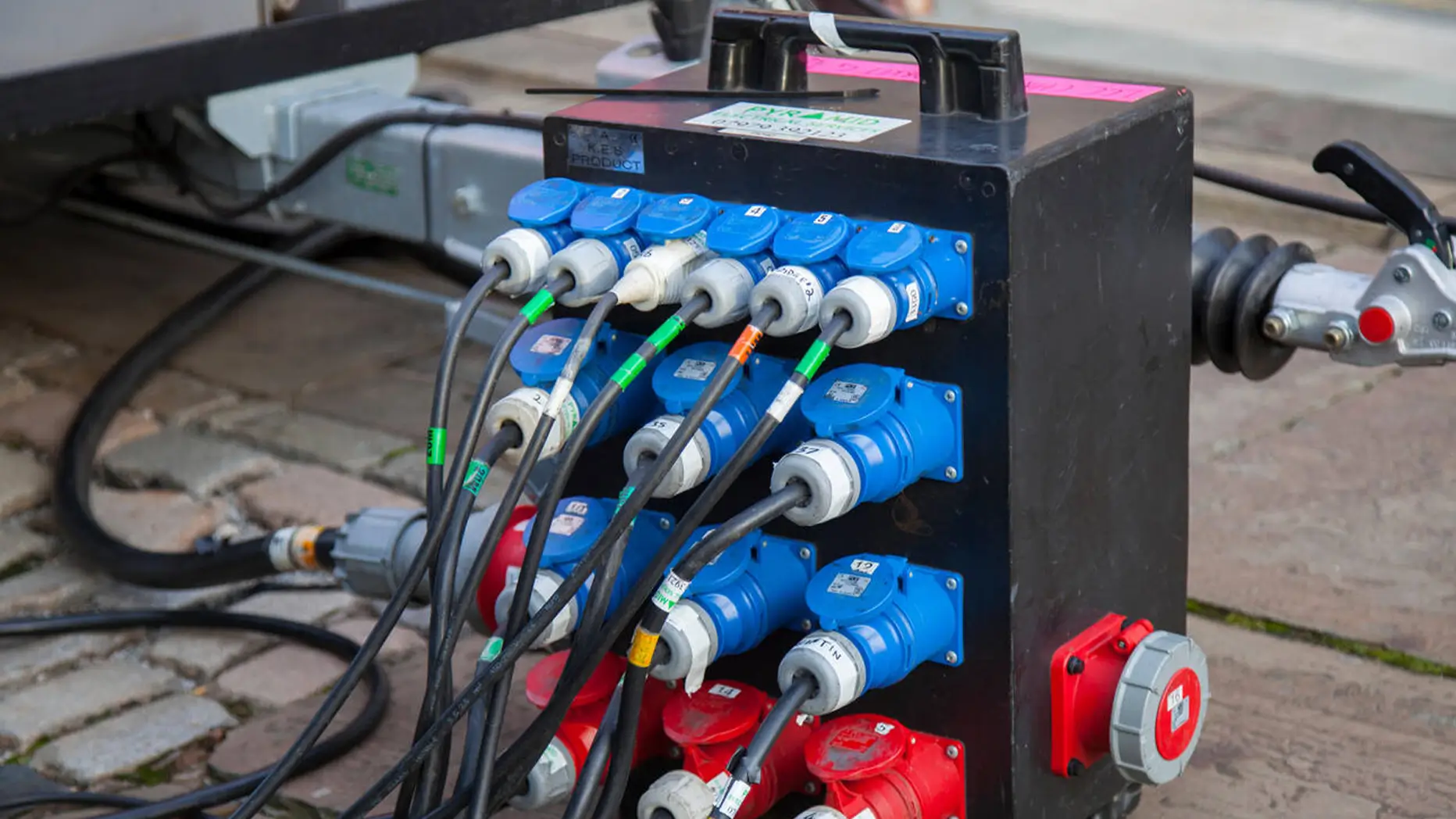Electrical installations for exhibitions, trade shows, and event stands are critical because they ensure a reliable and safe power supply for lighting, displays, audio-visual equipment, and other essential functions. Unlike permanent electrical systems, temporary electrical installations must not only be set up, but they also need to be operated and dismantled safely while ensuring efficiency and compliance with all regulations.
Taking proper steps to ensure adequate power supply and an electrical plan is part of an exhibit manager’s role. An electrical plan that fails to deliver can result in last-minute costly solutions.
This guide will provide an overview of key considerations, risks, and best possible practices for temporary electrical setups at events. It is based on industry standards, including BS 7671, IEC 60364-7-711, and HD 60364.7.711, which offer essential guidance on ensuring the safety, reliability, and compliance of temporary electrical installations.
What Are Temporary Electrical Installations?
Temporary electrical installations are systems designed to power exhibition booths, outdoor events, and temporary structures. As per their name, these systems are perfect for exhibition and show setups that require a timely power supply. These installations are not part of the permanent building infrastructure and must be designed for easy assembly and disassembly.
These systems include but are not limited to: generators, distribution panels, wiring, outlets, circuit breakers, and safety devices like RCDs (Residual Current Devices) to ensure safe and reliable power delivery.
Key Definitions To Understand
Exhibition: A temporary event showcasing products, services, or performances.
Show: A public or private display that requires electrical power.
Stand: A dedicated area or structure for sales, promotions, or exhibits.
Temporary Structure: A movable setup designed for easy installation and removal.
Temporary Electrical Installation: A power system installed and dismantled alongside the temporary structure.
Risks and Safety Considerations
Temporary electrical installations pose unique challenges, not just for your event or exhibition but also in terms of safety, including the risk of electric shocks, fire hazards, and mechanical stress. Given the public access to these setups, extra precautions must be taken.
Electric Shock: Unprotected wiring and improper grounding can lead to serious injuries.
Fire Risks: There can be fire hazards due to overloaded circuits and overheating equipment.
Mechanical Stress: Cables and connections may be exposed to high foot traffic and physical damage.
Public Safety: Unsecured installations can pose trip hazards and other risks to attendees.
Safety Regulations and Compliance
To mitigate these risks, compliance with safety standards is essential, and these key requirements include:
- Use of protective devices like Residual Current Devices (RCDs)
- Proper grounding and bonding of structures
- Ensuring all wiring is appropriately shielded from mechanical damage
- Installation of fire-resistant materials around high-heat equipment
System Types and Power Distribution
The type of electrical system used in temporary installations must comply with regulatory standards.
Permitted Earthing Systems
TN-S System: A preferred choice where separate neutral and earth conductors are used.
TT System: Used when TN-S is not feasible, requiring independent earthing electrodes.
Prohibited Systems
TN-C System: This system, which combines neutral and earth conductors, is not allowed.
TN-C-S System (PME): Not suitable due to challenges in bonding all conductive parts.
Electrical Protection Measures
Ensuring safety in temporary installations involves multiple protective strategies:
1. Residual Current Devices (RCDs)
Install RCDs with a no more than 300mA at the power supply source. Socket outlets up to 32A should be protected with RCDs of 30mA or less.
2. Protective Equipotential Bonding
Metal parts within a stand should be bonded to the earthing system. Bonding conductors should have a minimum cross-section of 4mm² copper.
3. Fire Safety Precautions
- All high-temperature electrical components must be positioned away from combustible materials.
- Ventilation should be provided for enclosed spaces containing electrical equipment.
- Only flame-retardant wiring and conduits should be used in the setup.
Best Practices For Wiring and Installation
Use Armored Cables: Protects against mechanical damage.
Flexible Cords: Should be kept away from public areas unless shielded.
Secure Fixtures: Lighting and other electrical equipment below 2.5m should be firmly fixed and guarded.
Identify Means of Isolation: Every temporary structure should have an accessible isolation switch.
Testing and Verification
Before an exhibition or show begins, the entire electrical installation must be inspected and tested to ensure compliance with BS 7671. Daily visual checks should identify potential hazards such as damaged cables or faulty connections.
Conclusion
Temporary electrical installations play a significant role in powering exhibitions and events, but they require careful planning, adherence to safety regulations, and proper execution to ensure reliability and security. By following the recommended practices and safety standards, organisers can provide a safe and efficient power supply for their exhibitions, reducing risks and ensuring compliance with electrical regulations.
